
2
Important safety information
Read this manual before attempting to install the device!
Failure to observe recommendations included in this manual may be
dangerous or cause a violation of the law. The manufacturer, Fibar Group
S.A. will not be held responsible for any loss or damage resulting from
not following the instructions of operating manual.
General carbon monoxide information
Carbon monoxide (CO) is a colourless, odourless, and tasteless poison
gas that can be fatal when inhaled. It is produced when liquid, solid, or
gas fuel is burned.
Symptoms of carbon monoxide poisoning
The early symptoms of carbon monoxide poisoning can be confused
with u-like symptoms: headache, dizziness and nausea. Breathing car-
bon monoxide causes these symptoms even in healthy people. It can
also cause sleepiness, vision problems (including blurred vision), ring-
ing in the ears, aching arms and legs, irregular breathing, fatigue and
confusion. At very high levels, it causes loss of consciousness and death.
Some external factors, eg. exposure to high concentration of basic
(non-acidic) gases, silicone vapors, hydrogen sulde or sulfuric acid gas,
organic vapors, contact with water, dust and oil mist, or dew condensa-
tion may aect the reliability of the device operation.
This device may not protect from long-term exposure to low levels of
carbon monoxide which can also lead to neurological symptoms.
The device is not a substitute for appropriate ventilation and exhaust
systems.
General information about
the FIBARO System
FIBARO is a wireless smart home automation system, based on the
Z-Wave protocol. All of available devices can be controlled through
a computer (PC or Mac), smartphone or tablet. Z-Wave devices (non-
battery powered) are not only receivers, but can also repeat the
signal, increasing the Z-Wave network’s range. It gives advantage
over traditional wireless systems that require direct link between
transmitter and receiver, as a result the construction of the building
could aect network’s range negatively.
Every FIBARO network has its unique identication number (home
ID). Multiple independent networks can exist in the building without
interfering. Transmission security of FIBARO System is comparable to
wired systems.
Z-Wave technology is the leading solution in smart home automation.
There is a wide range of Z-Wave devices that are mutually
compatible, independently of manufacturer. It gives the system the
ability to evolve and expand over time. For more information visit:
www.baro.com.



















